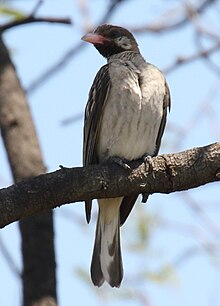
Bees are winged insects closely related to wasps and ants, known for their roles in pollination and, in the case of the best-known bee species, the western honey bee, for producing honey. Bees are a monophyletic lineage within the superfamily Apoidea. They are currently considered a clade, called Anthophila. There are over 20,000 known species of bees in seven recognized biological families. Some species – including honey bees, bumblebees, and stingless bees – live socially in colonies while most species (>90%) – including mason bees, carpenter bees, leafcutter bees, and sweat bees – are solitary.

A honey bee is a eusocial flying insect within the genus Apis of the bee clade, all native to mainland Afro-Eurasia. After bees spread naturally throughout Africa and Eurasia, humans became responsible for the current cosmopolitan distribution of honey bees, introducing multiple subspecies into South America, North America, and Australia.
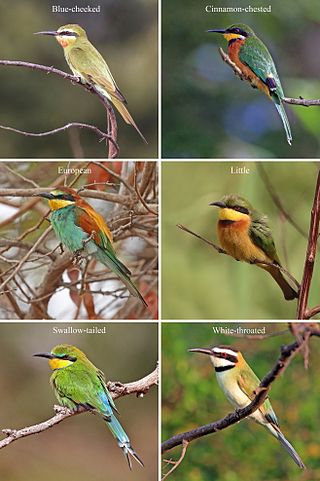
The bee-eaters are a group of birds in the family Meropidae, containing three genera and thirty species. Most species are found in Africa and Asia, with a few in southern Europe, Australia, and New Guinea. They are characterised by richly coloured plumage, slender bodies, and usually elongated central tail feathers. All have long down-turned bills and medium to long wings, which may be pointed or round. Male and female plumages are usually similar.

Honeyguides are near passerine birds in the order Piciformes. They are also known as indicator birds, or honey birds, although the latter term is also used more narrowly to refer to species of the genus Prodotiscus. They have an Old World tropical distribution, with the greatest number of species in Africa and two in Asia. These birds are best known for their interaction with humans. Honeyguides are noted and named for one or two species that will deliberately lead humans directly to bee colonies, so that they can feast on the grubs and beeswax that are left behind.

The honey badger, also known as the ratel, is a mammal widely distributed in Africa, Southwest Asia, and the Indian subcontinent. Because of its wide range and occurrence in a variety of habitats, it is listed as Least Concern on the IUCN Red List.

Brood parasitism is a subclass of parasitism and phenomenon and behavioural pattern of certain animals, brood parasites, that rely on others to raise their young. The strategy appears among birds, insects and fish. The brood parasite manipulates a host, either of the same or of another species, to raise its young as if it were its own, usually using egg mimicry, with eggs that resemble the host's.

A worker bee is any female bee that lacks the reproductive capacity of the colony's queen bee and carries out the majority of tasks needed for the functioning of the hive. While worker bees are present in all eusocial bee species, the term is rarely used for bees other than honey bees, particularly the European honey bee. Worker bees of this variety are responsible for approximately 80% of the world's crop pollination services.
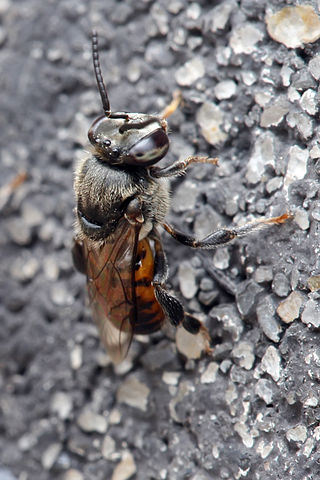
Stingless bees (SB), sometimes called stingless honey bees or simply meliponines, are a large group of bees (from about 462 to 552 described species), comprising the tribe Meliponini (or subtribe Meliponina according to other authors). They belong in the family Apidae (subfamily Apinae), and are closely related to common honey bees (HB, tribe Apini), orchid bees (tribe Euglossini), and bumblebees (tribe Bombini). These four bee tribes belong to the corbiculate bees monophyletic group. Meliponines have stingers, but they are highly reduced and cannot be used for defense, though these bees exhibit other defensive behaviors and mechanisms. Meliponines are not the only type of bee incapable of stinging: all male bees and many female bees of several other families, such as Andrenidae and Megachilidae (tribe Dioxyini), also cannot sting.
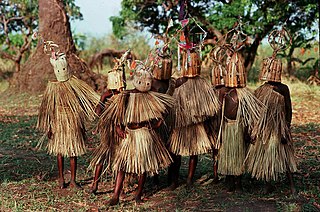
The Yao people are a major Bantu ethnic and linguistic group living at the southern end of Lake Malawi. They played an important role in the history of Southeast Africa, notably in the 19th century. The Yao are a predominantly Muslim-faith group of about two million, whose homelands encompass the countries of Malawi, the north of Mozambique, and the Ruvuma and Mtwara Regions of Tanzania. The Yao have a strong cultural identity, transcending national borders.

The yellow-rumped honeyguide is a sparrow-sized bird in the honeyguide family that is found in Asia, mainly in montane forests along the Himalayas. They are very finch-like but the feet are strong and zygodactyl, with two toes facing forward and two backward. They perch on honeycombs and feed on wax. Males tend to be territorial and stay near honeycombs while females and juveniles forage widely. They are brood parasites, laying their eggs in the nests of tree-hole breeders, possibly barbets.

Apis laboriosa or Himalayan giant honey bee, is the world's largest honey bee; single adults can measure up to 3.0 cm (1.2 in) in length. Before 1980, Apis laboriosa was considered to be a subspecies of the widespread Apis dorsata, the giant honey bee, but in 1980 and for almost 20 years thereafter it was elevated to the rank of a separate species. It was classified once again as a subspecies of Apis dorsata by Michael S. Engel in 1999, but was confirmed as a full species in 2020 on the basis of co-occurrence with Apis dorsata at many sites with no sign of interbreeding. It is highly adapted to its highland habitat in behavior.

The Hadza, or Hadzabe, are a protected hunter-gatherer Tanzanian indigenous ethnic group from Baray ward in southwest Karatu District of the Arusha Region. They live around the Lake Eyasi basin in the central Rift Valley and in the neighboring Serengeti Plateau. As of 2015, there are between 1,200 and 1,300 Hadza people living in Tanzania. However, only around 400 Hadza still survive exclusively based on the traditional means of foraging. Additionally, the increasing impact of tourism and encroaching pastoralists pose serious threats to the continuation of their traditional way of life.

Apis dorsata, the rock bee or giant honey bee, is a honey bee of South and Southeast Asia. They are typically around 17–20 mm (0.7–0.8 in) long and nests are mainly built in exposed places far off the ground, like on tree limbs, under cliff overhangs, and under buildings. These social bees are known for their aggressive defense strategies and vicious behavior when disturbed. Though not domesticated, indigenous peoples have traditionally used this species as a source of honey and beeswax, a practice known as honey hunting.

The Abyssinian scimitarbill is a species of bird in the family Phoeniculidae. The term Abyssinia, is an old name for the region of Ethiopia, and scimitar refers to a curved sword, which its bill resembles. It is found in Djibouti, Ethiopia, Kenya, Somalia, South Sudan, Tanzania, and Uganda. The bird is non migratory, diurnal, and terrestrial. Their nests are sometimes parasitized by the greater honeyguide which are favored by some because they can guide to beehives.

The least honeyguide is a small species of bird in the family Indicatoridae. It is found in sub-Saharan Africa.

The scaly-throated honeyguide is a species of bird in the family Indicatoridae. They have a mutualistic relationship with humans in which they attract beekeepers towards bees' nests and then feeding on the remains, especially larvae.
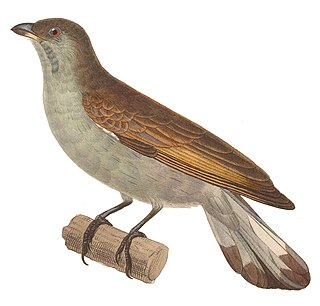
Indicator is a genus of near passerine birds in the honeyguide family. The name refers to the behaviour of some species, notably the greater honeyguide, which guide humans to bee colonies so that they can share in the spoils of wax and insects when the nest is broken into.

The western honey bee or European honey bee is the most common of the 7–12 species of honey bees worldwide. The genus name Apis is Latin for "bee", and mellifera is the Latin for "honey-bearing" or "honey carrying", referring to the species' production of honey.
In linguistics, displacement is the capability of language to communicate about things that are not immediately present ; i.e., things that are either not here or are not here now.

Mellivory is a term for the eating of honey. Honey is a sweet and viscous substance created by some eusocial insects, notably bees, for consumption by members of their hives, especially their young. Honey is also consumed by many other animals including human beings, who have developed beekeeping to make supplies of honey both reliable and plentiful. Despite honey's limited antimicrobial properties it remains a food source for a variety of microorganisms.
